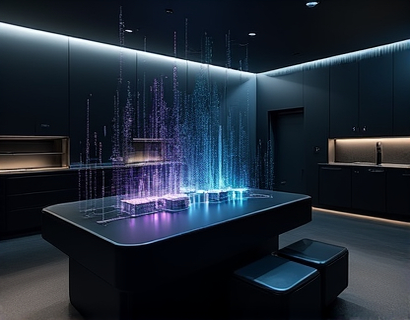Mastering Mindfulness: Innovative Software for Deep Relaxation and Stress Relief
In today's fast-paced world, finding moments of peace and tranquility can seem like an elusive goal. The constant barrage of notifications, the pressure to perform, and the demands of daily life can lead to chronic stress and a disconnected mind. However, with the advent of advanced mindfulness software, individuals are now equipped with powerful tools to manage stress and cultivate a balanced mind. This article delves into the transformative potential of these innovative solutions, highlighting how guided sessions, calming soundscapes, and mindfulness tools can revolutionize your approach to relaxation and stress relief.
The Importance of Mindfulness in Modern Life
Mindfulness, the practice of being fully present and engaged in the current moment, has gained significant traction in recent years due to its profound benefits for mental and physical health. Research has shown that regular mindfulness practice can reduce stress, improve focus, enhance emotional regulation, and even boost the immune system. In a world where stress is increasingly common, incorporating mindfulness into daily routines is more crucial than ever.
Traditional mindfulness practices such as meditation and deep breathing exercises have been proven effective, but they can be challenging to maintain, especially for beginners. This is where innovative software solutions come into play, offering a modern and accessible way to experience the benefits of mindfulness. These tools are designed to guide users through the process, making it easier to integrate mindfulness into even the busiest of schedules.
Key Features of Advanced Mindfulness Software
Modern mindfulness software is equipped with a range of features that cater to the diverse needs of users seeking relaxation and stress relief. Here are some of the key components that make these platforms effective and user-friendly:
- Guided Meditation Sessions: One of the most valuable features of mindfulness software is the availability of guided meditation sessions. These sessions are led by experienced instructors who walk users through each step, ensuring a smooth and immersive experience. Whether you are a beginner or an advanced practitioner, guided sessions can help deepen your practice and provide structure to your meditation routine.
- Calming Soundscapes: Sound plays a crucial role in creating a conducive environment for relaxation. Mindfulness software often includes a variety of calming soundscapes, from gentle rain and ocean waves to forest ambiance and soft instrumental music. These soundscapes can help mask distracting noises and create a serene atmosphere, enhancing the overall meditation experience.
- Mindfulness Tools: Beyond meditation and soundscapes, mindfulness software offers a range of tools to support mental well-being. These may include breathing exercises, body scans, and mindfulness prompts that encourage users to stay present and aware throughout the day. Some platforms also offer journaling features, allowing users to reflect on their thoughts and emotions, and track their progress over time.
- Customizable Profiles: To cater to individual preferences and needs, many mindfulness apps allow users to create customizable profiles. This feature enables users to set personal goals, choose specific types of sessions, and adjust the duration and frequency of their practice. A personalized approach ensures that the software remains relevant and engaging, encouraging consistent use.
- Progress Tracking: Monitoring progress is essential for maintaining motivation and seeing the benefits of mindfulness practice. Advanced software includes tools to track meditation sessions, duration, and consistency. Visual representations such as graphs and charts can provide a clear overview of progress, reinforcing the positive changes users are experiencing.
- Community Support: Feeling connected to others on a similar journey can be incredibly motivating. Some mindfulness platforms offer community features, such as forums, groups, and challenges, where users can share experiences, tips, and encouragement. This sense of community can enhance the overall mindfulness practice and foster a supportive environment.
Benefits of Using Mindfulness Software
The integration of mindfulness software into daily life offers numerous benefits that extend beyond mere relaxation. Here are some of the key advantages:
Firstly, mindfulness software makes it easier to establish a consistent meditation practice. With sessions available at various lengths and on-demand access, users can fit mindfulness into their schedules more seamlessly. This flexibility is particularly beneficial for those with busy lives, as it removes the barrier of time constraints.
Secondly, the guided nature of the sessions helps beginners overcome the initial hurdle of uncertainty. Many people find it challenging to meditate on their own, fearing they might do it wrong or not experience any benefits. Guided sessions provide reassurance and structure, making the practice more approachable and effective.
Thirdly, the use of calming soundscapes and ambient noises can have a profound impact on the mind and body. Research has shown that listening to soothing sounds can lower heart rate, reduce blood pressure, and decrease cortisol levels, the hormone associated with stress. By incorporating these elements, mindfulness software enhances the relaxation response, leading to a more profound state of calm.
Additionally, the mindfulness tools provided by these platforms address various aspects of mental health. Breathing exercises, for instance, can help manage anxiety and panic attacks by activating the parasympathetic nervous system, promoting relaxation. Body scans and mindfulness prompts encourage users to stay present, reducing rumination and enhancing emotional resilience.
Lastly, the data and insights offered by progress tracking features can be incredibly empowering. By visualizing their progress, users can gain a deeper understanding of how mindfulness is impacting their lives. This evidence of improvement can serve as a powerful motivator, encouraging continued practice and commitment to the mindfulness journey.
Creating a Mindful Daily Routine
Incorporating mindfulness software into your daily routine can transform your approach to stress management and mental well-being. Here are some practical steps to get started:
First, designate a specific time each day for your mindfulness practice. Consistency is key, so choose a time that works best for you, whether it's in the morning to start the day with a clear mind or in the evening to unwind before bed.
Next, create a dedicated space for your practice. This could be a quiet corner in your home, a comfortable chair, or even a peaceful outdoor spot. Ensure the environment is free from distractions and conducive to relaxation. Consider using the calming soundscapes feature to enhance the atmosphere.
When using guided sessions, start with shorter durations if you are new to meditation, gradually increasing the time as you become more comfortable. Experiment with different types of sessions to find what resonates with you the most. Some days, you might prefer a focused meditation, while others might benefit from a body scan or a loving-kindness meditation.
Utilize the mindfulness tools throughout the day to maintain a state of presence. Take a few moments to focus on your breath during breaks, practice deep breathing exercises when feeling stressed, or use a body scan to release tension. These small, regular practices can have a cumulative effect, reducing overall stress levels and improving mental clarity.
Finally, leverage the community features to stay motivated and connected. Engage with others in forums, participate in challenges, and share your experiences. The support and encouragement from fellow practitioners can be invaluable in maintaining a consistent mindfulness practice.
Overcoming Common Challenges
While mindfulness software offers many benefits, some users may encounter challenges that hinder their progress. Here are some common obstacles and tips on how to overcome them:
One common challenge is maintaining consistency. Life can be unpredictable, and it's easy to skip a session or two. To combat this, set reminders on your phone or integrate mindfulness into your daily routine, such as right after brushing your teeth or during your lunch break. Consistency is built over time, so be patient with yourself and celebrate small victories.
Another challenge is finding the right type of content. With so many guided sessions and soundscapes available, it can be overwhelming to choose what works best for you. Experiment with different instructors, genres, and lengths to discover your preferences. Don't hesitate to skip sessions that don't resonate and try something new.
Some users may also struggle with distractions, especially in noisy environments. To mitigate this, use noise-cancelling headphones or earplugs during sessions. If external noise is unavoidable, explore soundscapes that can help mask distracting sounds, creating a more immersive experience.
Lastly, it's important to approach mindfulness with an open and non-judgmental mindset. It's common to experience wandering thoughts or feel restless during meditation. Instead of getting frustrated, gently bring your focus back to your breath or the guided instructions. Remember, mindfulness is a skill that develops over time, and each session is a step forward.
Conclusion
In conclusion, innovative mindfulness software represents a significant advancement in the quest for relaxation and stress relief. By providing guided sessions, calming soundscapes, and mindfulness tools, these platforms empower individuals to integrate mindfulness into their daily lives, fostering a more balanced and peaceful existence. Whether you are a seasoned practitioner or a curious beginner, embracing mindfulness software can be a transformative step towards a healthier, more fulfilling life.










































